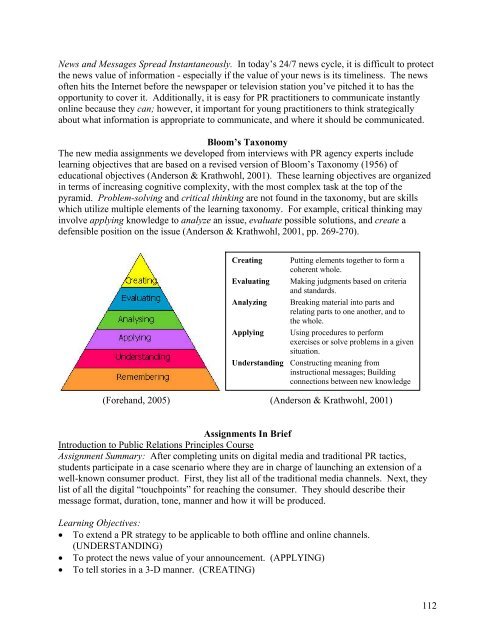2008 PROCEEDINGS - Public Relations Society of America
2008 PROCEEDINGS - Public Relations Society of America
2008 PROCEEDINGS - Public Relations Society of America
You also want an ePaper? Increase the reach of your titles
YUMPU automatically turns print PDFs into web optimized ePapers that Google loves.
News and Messages Spread Instantaneously. In today’s 24/7 news cycle, it is difficult to protect<br />
the news value <strong>of</strong> information - especially if the value <strong>of</strong> your news is its timeliness. The news<br />
<strong>of</strong>ten hits the Internet before the newspaper or television station you’ve pitched it to has the<br />
opportunity to cover it. Additionally, it is easy for PR practitioners to communicate instantly<br />
online because they can; however, it important for young practitioners to think strategically<br />
about what information is appropriate to communicate, and where it should be communicated.<br />
Bloom’s Taxonomy<br />
The new media assignments we developed from interviews with PR agency experts include<br />
learning objectives that are based on a revised version <strong>of</strong> Bloom’s Taxonomy (1956) <strong>of</strong><br />
educational objectives (Anderson & Krathwohl, 2001). These learning objectives are organized<br />
in terms <strong>of</strong> increasing cognitive complexity, with the most complex task at the top <strong>of</strong> the<br />
pyramid. Problem-solving and critical thinking are not found in the taxonomy, but are skills<br />
which utilize multiple elements <strong>of</strong> the learning taxonomy. For example, critical thinking may<br />
involve applying knowledge to analyze an issue, evaluate possible solutions, and create a<br />
defensible position on the issue (Anderson & Krathwohl, 2001, pp. 269-270).<br />
Creating Putting elements together to form a<br />
coherent whole.<br />
Evaluating Making judgments based on criteria<br />
and standards.<br />
Analyzing Breaking material into parts and<br />
relating parts to one another, and to<br />
the whole.<br />
Applying Using procedures to perform<br />
exercises or solve problems in a given<br />
situation.<br />
Understanding Constructing meaning from<br />
instructional messages; Building<br />
connections between new knowledge<br />
(Forehand, 2005) (Anderson & Krathwohl, 2001)<br />
Assignments In Brief<br />
Introduction to <strong>Public</strong> <strong>Relations</strong> Principles Course<br />
Assignment Summary: After completing units on digital media and traditional PR tactics,<br />
students participate in a case scenario where they are in charge <strong>of</strong> launching an extension <strong>of</strong> a<br />
well-known consumer product. First, they list all <strong>of</strong> the traditional media channels. Next, they<br />
list <strong>of</strong> all the digital “touchpoints” for reaching the consumer. They should describe their<br />
message format, duration, tone, manner and how it will be produced.<br />
Learning Objectives:<br />
• To extend a PR strategy to be applicable to both <strong>of</strong>fline and online channels.<br />
(UNDERSTANDING)<br />
• To protect the news value <strong>of</strong> your announcement. (APPLYING)<br />
• To tell stories in a 3-D manner. (CREATING)<br />
112
















